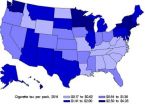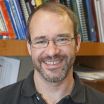(Press-News.org) AUDIO:
People who smoke cigarettes commit suicide at higher rates than those who don't smoke. That's been known for years, but most scientists assumed the reason was that smoking rates were...
Click here for more information.
Cigarette smokers are more likely to commit suicide than people who don't smoke, studies have shown. This reality has been attributed to the fact that people with psychiatric disorders, who have higher suicide rates, also tend to smoke. But new research at Washington University School of Medicine in St. Louis finds that smoking itself may increase suicide risk and that policies to limit smoking reduce suicide rates.
In a study published online July 16 in the journal Nicotine & Tobacco Research, a team led by Richard A. Grucza, PhD, reports that suicide rates declined up to 15 percent, relative to the national average, in states that implemented higher taxes on cigarettes and stricter policies to limit smoking in public places.
"Our analysis showed that each dollar increase in cigarette taxes was associated with a 10 percent decrease in suicide risk," said Grucza, associate professor of psychiatry. "Indoor smoking bans also were associated with risk reductions."
Grucza's team analyzed data compiled as individual states took different approaches to taxing cigarettes and limiting when and where people could smoke. From 1990 to 2004, states that adopted aggressive tobacco-control policies saw their suicide rates decrease, compared with the national average.
The opposite was true in states with lower cigarette taxes and more lax policies toward smoking in public. In those states, suicide rates increased up to 6 percent, relative to the national average, during the same time period. From 1990 to 2004, the average annual suicide rate was about 14 deaths for every 100,000 people.
"States started raising their cigarette taxes, first as a way to raise revenue but then also as a way to improve public health," Grucza explained. "Higher taxes and more restrictive smoking policies are well-known ways of getting people to smoke less. So it set a natural experiment, which shows that the states with more aggressive policies also had lower rates of smoking. The next thing we wanted to learn was whether those states experienced any changes in suicide rates, relative to the states that didn't implement these policies as aggressively."
Suicide is the 10th leading cause of death in the United States, according to the Centers for Disease Control and Prevention. In 2010, nearly 40,000 people died of suicide across the nation.
Every death that occurs in the United States is recorded in a database managed by the National Center for Health Statistics. Grucza's team classified each suicide death based on the state where the victim had lived, as well as how aggressive that state's tobacco policies were.
Using statistical methods, the researchers compared rates of suicide in states with stricter tobacco policies to rates in states with more lenient laws and lower taxes. They also determined whether people who had committed suicide were likely to have smoked. They learned that suicide risk among people most likely to smoke was associated with policies related to tobacco taxes and smoking restrictions.
"If you're not a smoker, or not likely ever to become a smoker, then your suicide risk shouldn't be influenced by tobacco policies," Grucza said. "So the fact that we saw this influence among people who likely were smokers provides additional support for our idea that smoking itself is linked to suicide, rather than some other factor related to policy."
Although scientists have known for years that people who smoke have a higher risk for suicide, they had assumed the risk was related to the psychiatric disorders that affect many smokers. These new findings, however, suggest smoking may increase the risk for psychiatric disorders, or make them more severe, which, in turn, can influence suicide risk.
"We really need to look more closely at the effects of smoking and nicotine, not only on physical health but on mental health, too," Grucza said. "We don't know exactly how smoking influences suicide risk. It could be that it affects depression or increases addiction to other substances. We don't know how smoking exerts these effects, but the numbers show it clearly does something."
He explained that many states still have low cigarette taxes, while other states haven't adopted comprehensive smoke-free air policies. Grucza predicts that if these states raise their cigarette taxes and restrict smoking in public, their suicide rates likely would fall.
Grucza suspects nicotine may be an important influence on suicide risk. Based on the study's results, he said he is concerned that many new restrictions on public smoking don't cover newer e-cigarettes, which deliver nicotine but release vapor rather than smoke. This mechanism purportedly allows those addicted to nicotine to get a "fix" without affecting the air others breathe.
"Nicotine is a plausible candidate for explaining the link between smoking and suicide risk," Grucza said. "Like any other addicting drug, people start using nicotine to feel good, but eventually they need it to feel normal. And as with other drugs, that chronic use can contribute to depression or anxiety, and that could help to explain the link to suicide."
INFORMATION:
The research was funded by the American Foundation for Suicide Prevention, the National Institute on Drug Abuse (NIDA) and the National Cancer Institute (NCI), both part of the National Institutes of Health (NIH). Additional funding was provided by the American Cancer Society. NIH grant numbers R01 DA031288, R01 DA026911, T32 DA07313, K01DA025733, P01 CA89392, U01 154248.
Grucza RA, Plunk AD, Krauss MJ, Carazos-Rehg PA, Deak J, Gebhardt K, Chaloupka FJ, Bierut LJ. Proving the smoking-suicide association: Do smoking policy interventions affect suicide risk? Nicotine & Tobacco Research, published online July 16, 2014.
Washington University School of Medicine's 2,100 employed and volunteer faculty physicians also are the medical staff of Barnes-Jewish and St. Louis Children's hospitals. The School of Medicine is one of the leading medical research, teaching and patient-care institutions in the nation, currently ranked sixth in the nation by U.S. News & World Report. Through its affiliations with Barnes-Jewish and St. Louis Children's hospitals, the School of Medicine is linked to BJC HealthCare.
Study: Smoking may contribute to suicide risk
Suicide rates linked to cigarette taxes, smoking policies
2014-07-16
ELSE PRESS RELEASES FROM THIS DATE:
Cell membrane proteins give up their secrets
2014-07-16
HOUSTON – (July 16, 2014) – Rice University scientists have succeeded in analyzing transmembrane protein folding in the same way they study the proteins' free-floating, globular cousins.
Rice theoretical biologist Peter Wolynes and his team at the university's Center for Theoretical Biological Physics (CTBP) have applied his energy landscape theory to proteins that are hard to view because they live and work primarily inside cell membranes.
The method should increase the technique's value to researchers who study proteins implicated in diseases and possibly in the ...
Are ants the answer to carbon dioxide sequestration?
2014-07-16
Boulder, Colo. – A 25-year-long study published in Geology on 14 July provides the first quantitative measurement of in situ calcium-magnesium silicate mineral dissolution by ants, termites, tree roots, and bare ground. This study reveals that ants are one of the most powerful biological agents of mineral decay yet observed. It may be that an understanding of the geobiology of ant-mineral interactions might offer a line of research on how to "geoengineer" accelerated CO2 consumption by Ca-Mg silicates.
Researcher Ronald Dorn of Arizona State University writes that over ...
Study: Robot-assisted surgery for prostate cancer controls the disease for 10 years
2014-07-16
DETROIT – Robot-assisted surgery to remove cancerous prostate glands is effective in controlling the disease for 10 years, according to a new study led by researchers at Henry Ford Hospital.
The study also suggested that traditional methods of measuring the severity and possible spread of the cancer together with molecular techniques might, with further research, help to create personalized, cost-effective treatment regimens for prostate cancer patients who undergo the surgical procedure.
The findings apply to men whose cancer has not spread beyond the prostate, and the ...
Seeing the glass as half full: Taking a new look at cognition and aging
2014-07-16
From a cognitive perspective, aging is typically associated with decline. As we age, it may get harder to remember names and dates, and it may take us longer to come up with the right answer to a question.
But the news isn't all bad when it comes to cognitive aging, according to a set of three articles in the July 2014 issue of Perspectives in Psychological Science.
Plumbing the depths of the available scientific literature, the authors of the three articles show how several factors — including motivation and crystallized knowledge — can play important roles in supporting ...
Fair cake cutting gets its own algorithm
2014-07-16
The next time your children quibble about who gets to eat which part of a cake, call in some experts on the art of sharing. Mathematician Julius Barbanel of Union College, and political scientist Steven Brams of New York University, both in the US, published an algorithm in Springer's The Mathematical Intelligencer by which they show how to optimally share cake between two people efficiently, in equal pieces and in such a way that no one feels robbed.
The cut-and-choose method to share divisible goods has been regarded as fair and envy-free since Biblical times, when ...
Borneo deforested 30 percent over past 40 years
2014-07-16
Forest cover in Borneo may have declined by up to 30% over the past 40 years, according to a study published July 16, 2014 in the open-access journal PLOS ONE by David Gaveau from the Center for International Forestry Research, Indonesia, and colleagues.
The native forests of Borneo have been increasingly impacted by logging, fire, and conversion to plantations since the early 1970s. Borneo lacks island-wide forest clearance and logging documentation, making forest conservation planning difficult, especially for selectively logged forests that have high conservation potential ...
Whale shark fringe migration
2014-07-16
At the fringe of the whale shark range, the volcanic Azore islands may play an increasing role for the north Atlantic population as sea surface temperatures rise, according to a study published July 16, 2014 in the open-access journal PLOS ONE by Pedro Afonso from University of the Azores and colleagues.
Whale sharks prefer tropical waters in the range of 26-30º C, but studies have shown that this large filter-feeding shark seasonally aggregates at highly productive coastal sites, sometimes at the edge of their preferred water temperature range. Whale sharks have been ...
Indus river dolphin's declining range
2014-07-16
Removal of river water for irrigation and habitat fragmentation by irrigation dams were shown to be the principal factors contributing to the decline of the Indus river dolphin, according to a study published July 16, 2014 in the open-access journal PLOS ONE by Gill Braulik from the Wildlife Conservation Society and University of St. Andrews and colleagues.
Many freshwater marine mammals are endangered due to rapidly degrading habitat and conservation of these megafauna species depends on maintaining intact habitat. This study used historical range data and information ...
Transplanting gene into injured hearts creates biological pacemakers
2014-07-16
LOS ANGELES (STRICTLY EMBARGOED UNTIL 2 P.M. EDT ON JULY 16, 2014) – Cardiologists at the Cedars-Sinai Heart Institute have developed a minimally invasive gene transplant procedure that changes unspecialized heart cells into "biological pacemaker" cells that keep the heart steadily beating.
The laboratory animal research, published online and in today's print edition of the peer-reviewed journal Science Translational Medicine, is the result of a dozen years of research with the goal of developing biological treatments for patients with heart rhythm disorders who currently ...
Sexual harassment and assault are common on scientific field studies, survey indicates
2014-07-16
CHAMPAIGN, Ill. — A survey of 142 men and 516 women with experience in field studies in anthropology, archaeology, geology and other scientific disciplines reveals that many of them – particularly the younger ones – suffered or witnessed sexual harassment or sexual assault while at work in the field.
A majority of the survey respondents (64 percent) said they had experienced sexual harassment (inappropriate sexual remarks, comments about physical beauty or jokes about cognitive sex differences, for example). And more than 20 percent reported they had been the victims ...
LAST 30 PRESS RELEASES:
Making lighter work of calculating fluid and heat flow
Normalizing blood sugar can halve heart attack risk
Lowering blood sugar cuts heart attack risk in people with prediabetes
Study links genetic variants to risk of blinding eye disease in premature infants
Non-opioid ‘pain sponge’ therapy halts cartilage degeneration and relieves chronic pain
AI can pick up cultural values by mimicking how kids learn
China’s ecological redlines offer fast track to 30 x 30 global conservation goal
Invisible indoor threats: emerging household contaminants and their growing risks to human health
Adding antibody treatment to chemo boosts outcomes for children with rare cancer
Germline pathogenic variants among women without a history of breast cancer
Tanning beds triple melanoma risk, potentially causing broad DNA damage
Unique bond identified as key to viral infection speed
Indoor tanning makes youthful skin much older on a genetic level
Mouse model sheds new light on the causes and potential solutions to human GI problems linked to muscular dystrophy
The Journal of Nuclear Medicine ahead-of-print tip sheet: December 12, 2025
Smarter tools for peering into the microscopic world
Applications open for funding to conduct research in the Kinsey Institute archives
Global measure underestimates the severity of food insecurity
Child survivors of critical illness are missing out on timely follow up care
Risk-based vs annual breast cancer screening / the WISDOM randomized clinical trial
University of Toronto launches Electric Vehicle Innovation Ontario to accelerate advanced EV technologies and build Canada’s innovation advantage
Early relapse predicts poor outcomes in aggressive blood cancer
American College of Lifestyle Medicine applauds two CMS models aligned with lifestyle medicine practice and reimbursement
Clinical trial finds cannabis use not a barrier to quitting nicotine vaping
Supplemental nutrition assistance program policies and food insecurity
Switching immune cells to “night mode” could limit damage after a heart attack, study suggests
URI-based Global RIghts Project report spotlights continued troubling trends in worldwide inhumane treatment
Neutrophils are less aggressive at night, explaining why nighttime heart attacks cause less damage than daytime events
Menopausal hormone therapy may not pose breast cancer risk for women with BRCA mutations
Mobile health tool may improve quality of life for adolescent and young adult breast cancer survivors
[Press-News.org] Study: Smoking may contribute to suicide riskSuicide rates linked to cigarette taxes, smoking policies




